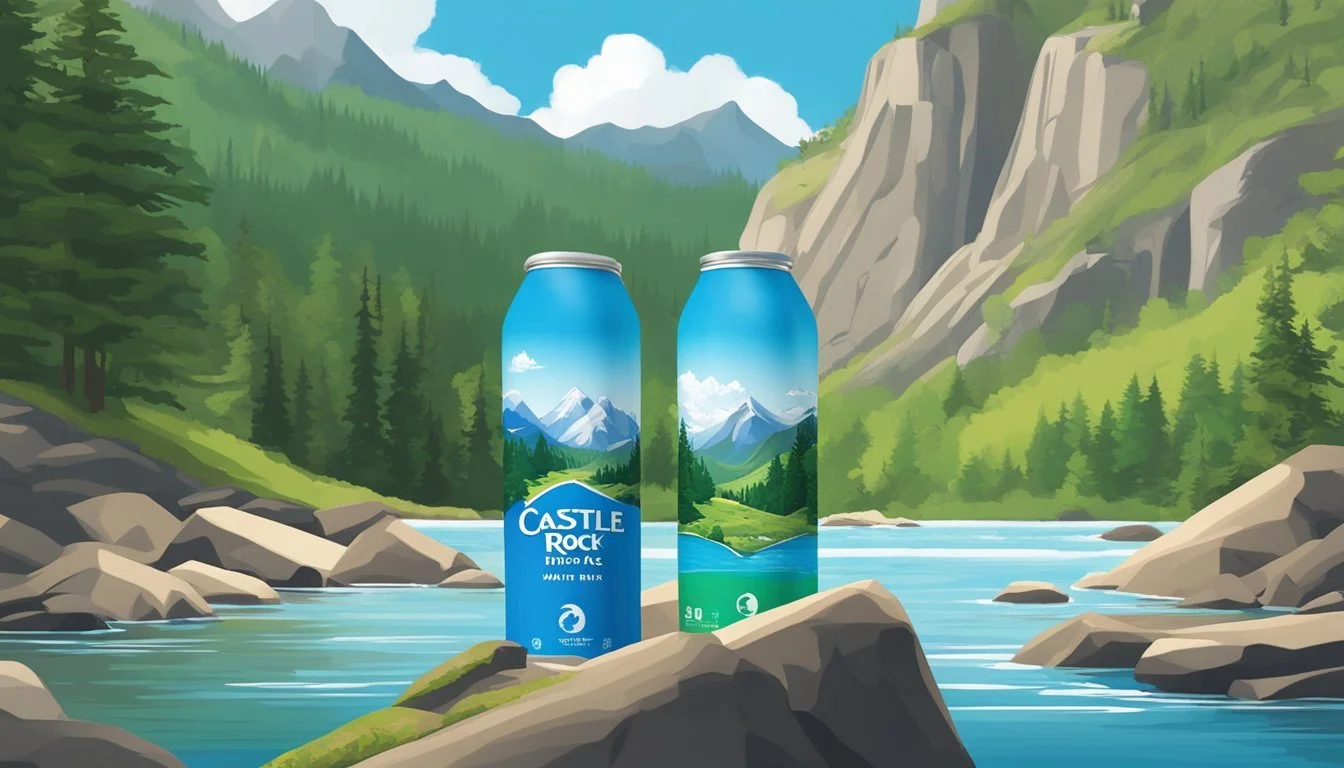Castle Rock vs. Augi
Which Bottled Water Is Better for You?
When it comes to bottled water, choosing the right brand can be a challenging task. Castle Rock water offers a unique experience by sourcing its water from the Shasta Spring and using environmentally friendly glass bottles, making it a top choice for eco-conscious consumers. On the other hand, Augi, purified from the Leesburg, Va., municipal supply, presents a different profile with its distinct taste, which some describe as having slight sulphuric undertones.
Castle Rock’s strong environmental stance and natural purification process attract many who prioritize sustainability and natural sources. Augi, while not as notable for its origin or packaging, delivers a reliable option for those looking for purified municipal water with a unique taste.
Choosing between Castle Rock and Augi ultimately hinges on personal preferences. For those who value natural spring sources and eco-friendly packaging, Castle Rock stands out. Conversely, those who appreciate the taste and origin of well-treated municipal water might find Augi more suitable.
Understanding Bottled Water
Bottled water comes from various sources and undergoes different purification processes to meet health standards. Consumers often choose bottled water for its perceived purity and convenience.
Origins and Sources
Bottled water can originate from groundwater, mountain springs, or municipal sources. Groundwater is typically extracted from underground aquifers, which can provide natural spring water depending on the geologic characteristics of the area.
Mountain spring water is sourced from springs high in the mountains, offering a naturally filtering process through rocks and sediments. Municipal sources commonly treat water from lakes, rivers, or reservoirs, subjecting it to purification methods to ensure its safety. For instance, Augi bottled water reportedly uses municipal water from Leesburg, Va., undergoing purification before bottling.
Health and Safety Standards
Health and safety standards for bottled water are primarily regulated by the FDA in the United States. The FDA ensures that bottled water complies with standards similar to those set by the EPA for public water systems. Bottled water companies must conduct regular testing for contaminants like bacteria, chemicals, and metals.
Water treatment processes often include filtration, UV light treatment, and ozonation to remove impurities and kill harmful microorganisms. These rigorous procedures ensure that bottled water is safe for consumption, regardless of its source. Consumers should check the water source and type on the label to verify its safety and compliance with regulatory standards.
Environmental Impact
The environmental impact of bottled water is considerable due to the use of plastic bottles and the energy required for production and transportation. Plastic bottles contribute significantly to waste and pollution if not properly recycled. Additionally, the extraction of water from natural sources can affect local ecosystems and water availability.
Efforts to mitigate the environmental impact include using recycled materials for bottles and encouraging proper recycling practices. Consumers can also reduce their environmental footprint by opting for reusable water bottles and local water sources when possible. Understanding these impacts helps make more environmentally conscious choices regarding bottled water consumption.
Evaluating Water Quality
When comparing Castle Rock and Augi bottled waters, it's important to focus on the taste profile, chemical composition, and pH levels. These factors significantly impact the water's quality and consumer preference.
Taste Profiling
Castle Rock is known for its clean, refreshing taste, drawing from Shasta Springs. The addition of natural carbonation adds to the crispness and enhances the drinking experience. A water sommelier might describe it as having a well-balanced mineral content that contributes to its purity.
Augi, on the other hand, comes from the Leesburg municipal water supply and is purified before bottling. Some tasters note a slight sulphuric taste, potentially off-putting to sensitive palates. It also lacks the natural spring source, which may influence its flavor negatively compared to Castle Rock.
Chemical Composition
Castle Rock's water contains naturally occurring minerals, which include essential electrolytes that contribute to its taste and potential health benefits. The water is free from artificial sweeteners, sodium, and preservatives, which ensures a natural drinking experience.
Augi’s bottling process involves significant purification, but tasters have noted slight, unusual tastes suggesting trace elements remain. The chemical composition of Augi could vary seasonally due to its municipal source, potentially affecting consistency.
pH and Alkalinity
Castle Rock water maintains a near-neutral pH level, with a slight tendency towards alkaline. This makes it suitable for balancing the body's pH levels, and the natural minerals further enhance its alkalinity, offering a slightly buffered taste.
Augi typically has a pH closer to neutral. However, due to its purification process, the alkalinity might be lower compared to naturally sourced spring water. This lower alkalinity can result in a less distinctive taste and may not offer the same balance benefits as Castle Rock.
Castle Rock Water: A Closer Look
Castle Rock Water is known for its commitment to quality and eco-friendly practices. In this section, we will explore its history, production process, and community sustainability efforts that have contributed to its reputation.
History of Castle Rock
Castle Rock Water originates from Mount Shasta in Northern California. The company was founded by Thomas Greither, who hails from a family with a history of wellness and health initiatives.
The water is sourced from Shasta Springs, near Dunsmuir, CA, which is known for its pristine and naturally occurring mineral waters. Over time, the brand has grown, maintaining a dedication to purity and sustainability.
Production Process
The production process of Castle Rock Water is designed to preserve the natural quality of the water. The water is lightly carbonated, ensuring a refreshing taste while maintaining its natural mineral content. Each bottle is crafted from 55% recycled glass, emphasizing the brand's commitment to environmentally friendly practices.
Castle Rock's bottling process avoids the use of plastic, which significantly reduces environmental impact. The water's journey from source to bottle is managed carefully to maintain its purity and fresh taste.
Community and Sustainability Efforts
Castle Rock is heavily invested in community and sustainability efforts. The company aims to provide a sustainable water supply for its consumers by utilizing eco-friendly packaging and renewable energy sources. They source approximately 30% of their water from renewable sources and 15% from reused or recycled water.
Castle Rock's ongoing investment in community initiatives includes education on water conservation and supporting local environmental projects. The company's packaging, made from recycled glass, highlights their dedication to reducing waste and promoting a greener planet.
Consumer's Guide to Selecting Bottled Water
When choosing bottled water, it's important to pay attention to labeling and brand transparency as well as the packaging considerations.
Labeling and Brand Transparency
Consumers should look for clear, comprehensive labels on bottled water. Labels should indicate the water source and whether the water is still or sparkling. Brands that are transparent about their sources, such as natural springs or artesian wells, often provide quality reports to ensure confidence in their product.
Many brands have detailed information on their websites, documenting purity levels and any additives present. Checking these reports helps in confirming the authenticity and quality of the water. Reliable brands will not only provide this information but will be consistent in maintaining high standards across their products.
Packaging Considerations
The type of packaging can greatly influence the environmental impact and safety of bottled water. Recyclable materials like PET plastic and glass are preferable to reduce environmental footprint. Moreover, opting for BPA-free bottles is essential to avoid potential health hazards.
Consumers might prefer larger, reusable containers to minimize plastic waste. The design and usability of the bottle, such as features for ease of carrying and drinking, also play a significant role. Packaging design should ensure the water remains untainted and fresh, with airtight seals to prevent contamination.
Choosing brands committed to sustainable practices, such as using eco-friendly packaging or participating in recycling programs, further enhances the consumer's positive impact.
Market Comparison
Castle Rock and Augi are both prominent names in the bottled water market, known for their premium quality. This section dissects their standing in the market regarding competition, pricing, and accessibility.
Competitive Analysis: Castle Rock vs. Other Premium Brands
Castle Rock's reputation for crisp, refreshing spring water places it in direct competition with other luxury brands like Evian, Fiji Water, and Smartwater. Its distinct flavor, often likened to the purity found in a morning hike, differentiates it in the crowded market.
Augi, on the other hand, targets health-conscious consumers, competing closely with brands such as Core Hydration and Essentia, which emphasize high pH levels and added electrolytes. Both Augi and Castle Rock have carved out niches but appeal to slightly different consumer bases.
Price Point Evaluation
Castle Rock is positioned at the mid-to-high end of the pricing spectrum, generally costing more than standard brands like Aquafina and Poland Spring but comparable to other premium choices. A typical 500ml bottle of Castle Rock might range from $1.50 to $2.00, reflecting its premium status and quality.
Augi's pricing is competitive within the premium segment, often found at a similar range as Castle Rock. Despite its high-quality credentials, Augi's pricing strategy aims to offer slightly better value by incorporating additional health benefits such as enhanced minerals at no extra cost.
Availability and Convenience
Castle Rock is widely available in grocery stores and specialty shops across the United States and Canada. Its distribution ensures that consumers can find it easily, fostering convenience for regular buyers.
Augi, while also present in major grocery chains, has a strong online presence, making it accessible for direct-to-consumer purchases. Both brands ensure broad availability, but Augi's online strategy potentially offers greater convenience for tech-savvy consumers.
Individual Health and Environmental Responsibility
Choosing between bottled water brands like Castle Rock and Augi involves considerations about both individual health and environmental impacts.
Making Eco-Friendly Choices
Opting for recycled glass or boxed water can significantly reduce environmental footprints. Castle Rock's commitment to renewable packaging materials aligns well with eco-friendly consumption. Conversely, Augi's focus on plastic bottles raises concerns about pollution and waste.
Consumers should consider alternatives such as tap water or water from environmentally sustainable sources. It's essential to focus on brands that prioritize reduction of carbon emissions and water conservation. For someone looking to make a greener choice, Castle Rock's integration of eco-friendly practices might offer a more sustainable solution.
Understanding Water Certifications
Certifications play a crucial role in assessing water quality and environmental responsibility. Castle Rock is distinguished by its For Life - Social Responsibility certification, indicating stringent adherence to social and ecological standards. This certification examines aspects such as labor practices, environmental management, and long-term sustainability.
Augi, although recognized for its widespread availability, lacks high-profile certifications tied to social responsibility. Given the prevalence of tap water in bottled water, rigorous certification ensures safer and cleaner drinking options. For health-conscious individuals, choosing bottles verified by reputable organizations assures fewer contaminants and high-quality hydration.
Final Thoughts
When comparing Castle Rock and Augi, several factors stand out.
Castle Rock is lauded for its natural spring water source. Their water undergoes minimal processing, helping to retain its natural minerals. This can be beneficial for those seeking a more organic option. The taste is often described as clean and refreshing, making it appealing to a broad audience.
Augi is a purified water sourced from the Leesburg, Va., municipal water supply. It undergoes treatment to ensure safety and purity. Some reviewers note a slight sulphuric taste, which might not be favorable to everyone. Despite this, it remains a popular choice for its accessibility and affordability.
Taste Test Results:
Many prefer the crispness of Castle Rock.
Augi's taste can sometimes border on fishy, which is less appealing.
Availability:
Castle Rock may not be as widely available as Augi.
Augi's municipal sourcing makes it more readily accessible.
In terms of price, Augi generally comes in as the more economical choice, while Castle Rock can be a bit pricier due to its natural spring sourcing.
Considering these points, the choice between Castle Rock and Augi will largely depend on personal preference regarding taste, availability, and cost. Each brand has its own unique benefits and potential drawbacks.
The decision ultimately hinges on what the consumer values most in their bottled water.




